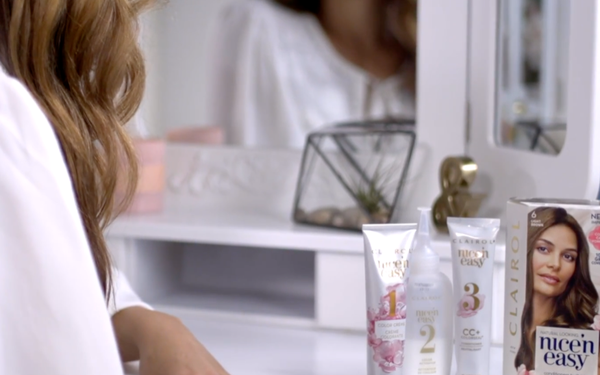health and beauty aids
Hair Color Crisis? Clairol Taps Google Assistant For Help
- by Sarah Mahoney @mahoney_sarah, December 6, 2018

Considering how messy home hair coloring can be, it’s astonishing it has taken this long: Coty is introducing the Clairol Color Expert for Google Assistant.
The hands-free option provides advice on every step of the process. A simple “Hey, Google, talk to Clairol” activates advice on everything from picking the right shade to the final rinse.
Coty claims it’s the first such innovation for hair color, and says it worked with Google to identify category challenges, then combined them with insights about how and where people use voice assistants.
Marketing for the new feature “will be rolled out more broadly in January, when you will hear a lot of our creators and influencers talking about it, and more socialization at shelf,” says Fred Gerantabee, Coty’s vice president of digital innovation.
advertisement
advertisement
He tells Marketing Daily that the beauty company decided to work with Google Assistant on the project because it “offered us a unique opportunity to bring a service across several touchpoints of the user journey, from mobile phones at shelf to smart speakers at home, and eventually build on more devices, such as smart TVs, as those continue to proliferate. We have done great work on the Alexa platform as well, but …they are distinctively different platforms that suit themselves to different approaches.”
Coty built the Clairol’s Color Expert with Beamly, its in-house marketing tech agency, and agency Voxly Digital. It says Google Assistant is available on more than 500 million devices, and is a particular favorite of the 18- to 34-year-old women who color their hair at home.
Clairol knows a little about offering a lifeline for hair color — it established its 1-800 Clairol helpline back in 1970.
By comparison, Butterball, which launched a voice-activation partnership with Amazon’s Alexa this year, didn’t introduce its helpline for turkey cooks until 1981.
Marketers like Clairol and Butterball are just beginning to use voice as a content marketing and customer engagement tool.
A report from Capgemini, based on a survey of some 5,000 people in the U.S., U.K., France and Germany, estimated that voice assistants are likely to become a dominant mode of consumer interaction within three years. Streaming music and seeking information remain the most popular requests for voice assistants, but 35% of survey respondents say they have used assistants to buy something. Overall, 71% find the experience to be positive.
“Brands who provide good voice-assistant experiences will generate more business and positive word-of-mouth communication,” Capgemini says, with 37% of users saying they would share a positive experience with friends and family.
Marketers are still experimenting to find the right mix. “The voice assistant is part of a larger ecosystem of Clairol solutions,” along with video tutorials, augmented reality and messaging, says Gerantabee. “Google Home addressed a very specific real-time need that other channels could not in the same way,” he adds.
But all the company’s tech offerings are designed to “accommodate different parts of the consumer journey and collectively address the needs that we know are inherent in the category.”
Despite Coty’s tech innovations -- including ambitious AR experiences with its CoverGirl brand and an AI-driven anti-bullying effort -- the company is currently navigating choppy waters. Moody’s recently downgraded Coty’s debt rating, citing “meaningful operational challenges” as it continues to wrestle with supply chain issues and the integration of Clairol, CoverGirl and other brands acquired from Procter & Gamble back in 2016.
Considerable executive turnover hasn’t helped, either. “The company's profitability will also be adversely affected by high promotional activity needed to support sales during the holiday season,” Moody’s says in its report.




